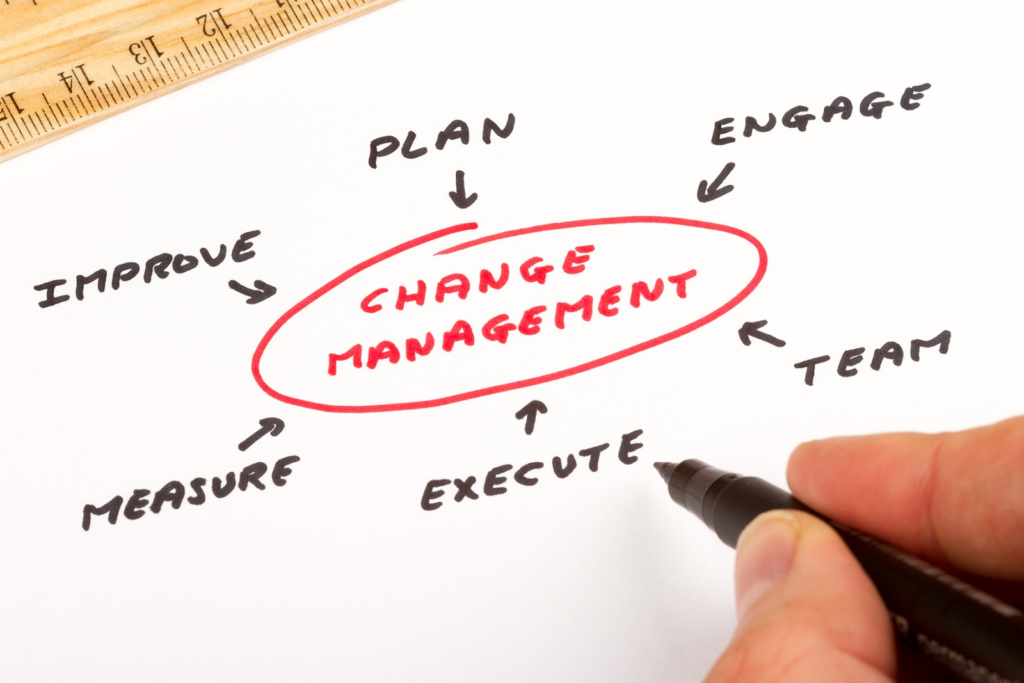
Source: Invensislearning
Workplace changes can throw people into a tizzy. Imagine your manager moved you to a new team overnight. You’d have to understand your new team’s processes, technologies, and work styles. In turn, this confusion could impact productivity, and cause frustration and stress. The change management best practices I discuss in this article can help you avoid the stress.
Big and small changes are an essential part of every business lifecycle. Changes can include keeping employees trained and happy or ensuring technology is efficient and safe. Regardless of the cause, businesses need to change to fight the competition. However, change is difficult to manage. Poor change processes cause service disruptions and increase operational costs. Change management enables businesses to effect changes without negative consequences.
In this article, I’ll explore details of types of changes and change management models. I’ll also outline the top 5 best practices in change management. But first, let’s understand what change management is.
What Is Change Management?
Change management is the systematic approach to putting any change in place. Major changes are challenging and need large-scale collaboration. In essence, change management ensures that all major and minor changes occur seamlessly and successfully.
Change management practices provide a structured guideline to prevent service disruptions. They help personnel adapt to the change. They include actions like:
- Preparing a change plan
- Creating a knowledge base that answers common FAQs
- Supporting employees during the change
- Monitoring activities before and after the change
Before I explain best practices in change management, let’s go over the possible types of organizational changes.

Types of Organizational Change
Organizational changes often involve significant changes to personnel, company goals, services, and technology. Each type of change requires a separate change management strategy.
Strategic Change
Strategic changes occur when a company identifies new goals, opportunities, or threats. For example, adjusting operations at a large scale to adapt to changing conditions.
Structural Change
Structural changes are modifications to the organizational structure that affects the process flow. For example, managerial hierarchy or team company changes due to mergers and acquisitions.
Technological Change
Technology affects the way companies conduct business. Technological changes aim to improve process efficiency. For example, introducing new software or systems to the team. But, the learning curve associated with integrating new technology is steep.
Unplanned Change
As the name implies, these are changes that the company doesn’t prepare for. They happen unexpectedly and significantly impact business processes. These changes aren’t ideal, but they’re inevitable. For example, the COVID-19 pandemic prompted many companies to support remote work.
Any type of change becomes difficult due to specific challenges. Let’s discuss the challenges you could face while implementing change management techniques.
Change Management Challenges
Change becomes difficult if:
- Your company fails to define its goals clearly
- Leaders are absent or incapable
- Communication failure leads to misalignment and pushback from employees
- The change management process lacks decisiveness or commitment
Companies may struggle to identify resources needed to make the change smooth. These resources can be financial, personnel, technology, etc. The question left to be answered is: how do you implement change successfully? Every situation is unique; we can’t prescribe an exact process. Experts suggest using a change management model for an efficient transition.
But many types of change management models exist, so which do you use? I get it can be confusing. Now, I’ll explain 3 of the most common change models with a proven success record. These can also influence your best practices in change management, so pay attention!
Top 3 Change Management Models
A change management model forces you to analyze changes from different perspectives. It gives structure to your entire change strategy.
1. McKinsey 7S Model
The McKinsey 7S Model harmonizes 7 key elements:
- Strategy: Set of actions that a firm plans to achieve the change
- Systems: Informal and formal resource allocation, reward, and measurement procedures
- Structure: The division of tasks to achieve change, integration, and coordination
- Staff: Human resources, their education, and attitude
- Style: Behavior pattern of personnel involved in the change
- Shared Values: Key aspirations and beliefs that form the team culture
- Skills: Distinctive capabilities and core competencies required for change
The model requires you to balance the different elements throughout the transition. For example, if you create a new team, you must assess the impact on all other aspects. You have to support existing staff and evaluate skills the new team should have.

2. ADKAR Model
The ADKAR Model is a five-step sequential process for change management. It focuses on developing internal motivation in people to support any transition. The 5 steps are to:
- Raise awareness about the need for change
- Inspire an inner desire in others to support and participate in the change process
- Build knowledge on what to change and how to do it
- Inspire confidence in the ability to implement the change
- Reinforce or reward goal achievements that sustain the change
Analyzing the consequences of your change helps you create a comprehensive game plan.
3. Kotter’s 8-Step Change Model
Kotter’s model proposes an 8-step cyclical approach to change management. You break down a change into small, achievable goals. You then build momentum and get your team to complete 8 stages to achieve the first goal. These stages are:
- Create a sense of urgency that motivates people to make the change
- Build a core team of managers and leaders that champion the change
- Form a shared vision that drives change strategies and initiatives
- Encourage employees to adopt the change voluntarily
- Remove obstacles, so more employees feel comfortable accepting the change
- Recognize and reward employees who make small changes successfully
- Sustain change by automating tasks and improving efficiency
- Institute the change as part of the company culture
You repeat this continuously till you accomplish the final change. In the end, Kotter’s model encourages companies to document the new process. They can train new employees so that changes are part of the company’s best practices.

You can select and implement any model that suits your requirements. The model serves as a framework for shared responsibilities and the top 5 change management best practices I outline below.
5 Best Practices in Change Management
I’ve outlined 5 best practices in change management. You can follow these regardless of the change management model you choose.
1. Involve Employees
Preparation involves helping employees recognize and understand the need for change. Managers should involve employees in identifying goals, scope, risks, and mitigation. Everyone can identify key performance metrics, set targets, and work towards them.
For example, consider a company moving to a new timesheet system. They set a target that 60% of employees will start logging timesheets on the new system in three months. If the employees know about this target, they’ll most likely adhere to the change better.
2. Mobilize Active and Visible Sponsorship
Identify a committed leader for the change. This leader motivates others and influences key decisions. They’re always accessible and visible in the transition process. The leader is also responsible for communicating correct information to the suitable personnel.
For example, the company appoints the IT manager to champion the new timesheet system. The IT manager handles creating employee accounts and supports the HR team in collecting data from the new system.
3. Apply a Structured Change Management Approach
Adopting a structured approach makes the process repeatable and scalable. It creates a framework you can use to stay on track throughout the change process. Companies may adopt an established change management model or develop a new one.
For example, the IT Manager uses the ADKAR model to start change. He raises awareness about problems with the current system. He talks about lost timesheets and delays in salary payment processing. Management offers a 5% bonus to the first 100 employees that move to the new system.
4. Simplify Change Processes
Employees understand and adopt change better when the change process is simple. Change managers can communicate simplified procedures effectively, leading to desired outcomes. You can also use artificial intelligence and other technology to automate change processes. By eliminating repetitive tasks, change managers can make the process more efficient.
For example, the company creates a knowledge base about the new system. After the first step, it can log timesheet data automatically with employee approval.
5. Incentivize and Celebrate Goals
Employees feel motivated when they buy into your vision. You have to train and incentivize them to adapt. Building knowledge is essential but not enough. You have to motivate your employees, from knowing about something to actually doing it. This includes a combination of support and celebrating small achievements. All communications must be comprehensive and transparent. You may collaborate across teams to avoid unwelcome surprises that reduce momentum!
For example, the company announces milestones when more staff join the system.
I hope these practices will support your change management efforts. Let’s take a quick look at everything I’ve discussed so far.
Final Words
Change is inevitable but challenging for companies. Most struggle with unclear goals, incomplete communication, and absent leadership. Besides, several different types of changes can disrupt operations.
Change management is a structured process to make transitions smooth and efficient. It’s best to choose a change management model that gives a clear framework to achieve your goals. You can then follow best practices while applying the model for successful adoption.
The best practices in change management focus on people. An active leader who inspires and motivates all stakeholders is a key part of this. You must also focus on making processes simple, structured, and automated. This way, you enjoy more efficiency!
Got more questions? Learn more about change management in the FAQ and Resource sections below.
FAQ
What are the phases of change management?
Kurt Lewin described three phases of change management in his book. These phases include; unfreezing the current state, changing the system, and refreezing. The unfreezing step involves identifying a need for change. The changing phase involves working to create the change. This phase also deals with setbacks in the process. Refreezing involves making the new system the status quo.
What are the benefits of change management?
Change management helps companies save valuable time and resources throughout a change process. People are naturally opposed to change. Change management helps companies combat this resistance to change. It also helps companies judge the success or failure of the change process.
What are change management tools?
Change management tools are digital technologies that simplify change management. These tools enable the change management process’s analysis, automation, and measurement. Change management tools feature change logs, Gannt charts, flowcharts, and work breakdown structure. Some popular change management tools include ChangeGear, eChangeManager, and Freshservice.
How do you measure change management success?
You can analyze the effectiveness of your change management strategy using different metrics. The success rate of changes and average time to change are popular measures. The number of failed or emergency changes should decrease. Overall, the number of rejected changes should also go down. Everyone in your company should become more willing to embrace change.
Who is a change manager?
A change manager describes personnel responsible for monitoring and supervising organizational changes. The change manager is crucial to the entire change process. They design change management plans and oversee their implementation. The change manager is also tasked with motivating other staff members to embrace the process as well as improve business security. Every company must have one or more change managers.
Resources:
TechGenix: Newsletters
Subscribe to our newsletters for more quality content.
TechGenix: Guide on Risk Management
Read about our comprehensive guide to enterprise risk management.
TechGenix: Guide on Incident Management
Discover how incident management works and the best software to manage it.
TechGenix: Article on Risk Management Frameworks
Explore how to implement a risk management framework.
TechGenix: Guide on Cloud Data Management
Learn more about cloud data management and the benefits it brings.



